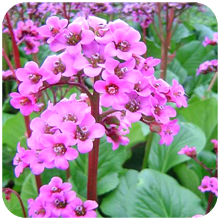
Bergenia ligulata is a perennial herb with short, thick, fleshy and procumbent stems and very stout root stock. Leaves are ovate or round and 5-15 cm long at flowering time (Flowering period March- May). In the autumn, leaves turn to bright red with short stiff hairs and attain about 30 cm length. Upper and lower surfaces of leaves are hairy, becoming almost hairless in age. Flowers are white, pink or purple, 3.2 cm in diameter, forming a cymose panicle with flexible flowering stem, 10-25 cm long leafless and styles.
Chemical composition – Contains major phenolic compound “bergenin”. Other phenolics include afzelechine, leucocyanidine, gallic acid, tannic acid, methyl gallate, catechine, catechine 7-O-ß-D-glucopyranoside, 11-O-Galo bergenin, lactone- Paashaanolactone. It also contains sterols- Sytoindoside 1, beta-sitosterol and beta-sitosterol-D-glucoside, glucose, tannin, mucilage and wax.
The rhizomes contain coumarins: bergenin, 11-0-galloyl bergenine, 11-OP-hydroxy-benzoyl bergenine; 11-O-brotocatecuoyl bergenine, 4-0-galloyl bergenine. Flavonoids: afzelechine, avicularine, catechine, eryodicthyol-7-O-β-D-glucopyranoside, renoutrin. Benzenoide: arbutin, 6- OP- hydroxy-benzoyl arbutin, 6-O-protocatechuoil arbutin; 4-Hydroxy acids etc..
Properties – Antiurolithic, antiviral, antioxidant, antidiabetic, hepatoprotector, diuretic, analgesic, hypermagneseuric, litholytic, anti-aging.
Recommendation – Urolithiasis, influenza, urinary calculi, swelling, abscesses and skin infections, diabetes, and hemorrhoids menorrhagia, dysmenorrhea, diarrhea, dysentery, heart disease and splenic cough and cold.
This plant is incorporated in natural remedies PROSTATOSALM, URINOSALM.




